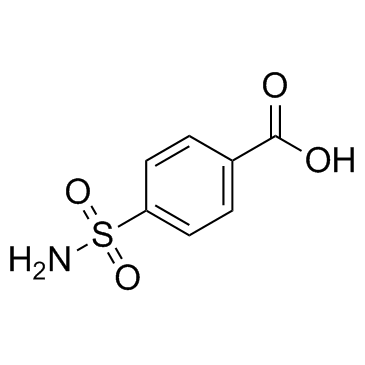Carzenide

Carzenide structure
|
Common Name | Carzenide | ||
|---|---|---|---|---|
| CAS Number | 138-41-0 | Molecular Weight | 201.200 | |
| Density | 1.5±0.1 g/cm3 | Boiling Point | 449.0±47.0 °C at 760 mmHg | |
| Molecular Formula | C7H7NO4S | Melting Point | 285-295 °C(lit.) | |
| MSDS | Chinese USA | Flash Point | 225.4±29.3 °C | |
|
Carbonic anhydrase inhibitors. Inhibition studies with anions and sulfonamides of a new cytosolic enzyme from the scleractinian coral Stylophora pistillata.
Bioorg. Med. Chem. Lett. 21 , 710-4, (2011) The catalytic activity and the inhibition of a new coral carbonic anhydrase (CA, EC 4.2.1.1), from the scleractinian coral Stylophora pistillata, STPCA-2, has been investigated. STPCA-2 has high catalytic activity for the physiological reaction being less sen... |
|
|
Cloning, characterization and sulfonamide inhibition studies of an α-carbonic anhydrase from the living fossil sponge Astrosclera willeyana.
Bioorg. Med. Chem. 20 , 1403-10, (2012) The α-carbonic anhydrase (CA, EC 4.2.1.1) Astrosclerin-3 previously isolated from the living fossil sponge Astrosclera willeyana (Jackson et al., Science 2007, 316, 1893), was cloned, kinetically characterized and investigated for its inhibition properties wi... |
|
|
Inhibition studies of the β-carbonic anhydrases from the bacterial pathogen Salmonella enterica serovar Typhimurium with sulfonamides and sulfamates.
Bioorg. Med. Chem. 19 , 5023-30, (2011) The two β-carbonic anhydrases (CAs, EC 4.2.1.1) from the bacterial pathogen Salmonella enterica serovar Typhimurium, stCA 1 and stCA 2, were investigated for their inhibition with a large panel of sulfonamides and sulfamates. Unlike inorganic anions, which ar... |
|
|
Optimizing Multiple Analyte Injections in Surface Plasmon Resonance Biosensors with Analytes having Different Refractive Index Increments.
Sci. Rep. 5 , 15855, (2015) Surface plasmon resonance-based biosensors have been successfully applied to the study of the interactions between macromolecules and small molecular weight compounds. In an effort to increase the throughput of these SPR-based experiments, we have already pro... |
|
|
Mutagenicity study of Remsen-Fahlberg saccharin and contaminants.
Toxicol. Lett. 7(1) , 51-60, (1980) Saccharin and contaminants of commercial Remsen-Fahlberg saccharin were studied for mutagenic potential with the use of the Salmonella/microsome test, Basc-test in Drosophila melanogaster and micronucleus test in mice. In none of these tests were mutagenic ef... |
|
|
Saccharin: para forms of some impurities are not mutagenic in Salmonella typhimurium.
Food Cosmet. Toxicol. 18(4) , 453, (1980)
|
|
|
Cloning, characterization, and inhibition studies of a beta-carbonic anhydrase from Brucella suis.
J. Med. Chem. 53 , 2277-85, (2010) A beta-carbonic anhydrase (CA, EC 4.2.1.1) from the bacterial pathogen Brucella suis, bsCA 1, has been cloned, purified, and characterized kinetically. bsCA 1 has appreciable activity as catalyst for the hydration of CO(2) to bicarbonate, with a k(cat) of 6.4... |
|
|
Carbonic anhydrase inhibitors. Characterization and inhibition studies of the most active beta-carbonic anhydrase from Mycobacterium tuberculosis, Rv3588c.
Bioorg. Med. Chem. Lett. 19 , 6649-54, (2009) The Rv3588c gene product of Mycobacterium tuberculosis, a beta-carbonic anhydrase (CA, EC 4.2.1.1) denominated here mtCA 2, shows the highest catalytic activity for CO(2) hydration (k(cat) of 9.8 x 10(5)s(-1), and k(cat)/K(m) of 9.3 x 10(7)M(-1)s(-1)) among t... |
|
|
Molecular cloning, characterization, and inhibition studies of the Rv1284 beta-carbonic anhydrase from Mycobacterium tuberculosis with sulfonamides and a sulfamate.
J. Med. Chem. 52 , 2226-32, (2009) The beta-carbonic anhydrase (CA, EC 4.2.1.1) encoded by the gene Rv1284 (mtCA 1) of Mycobacterium tuberculosis shows appreciable catalytic activity for CO(2) hydration, with a k(cat) of 3.9 x 10(5) s(-1) and a k(cat)/K(m) of 3.7 x 10(7) M(-1) s(-1). A panel o... |
|
|
Cloning, expression, post-translational modifications and inhibition studies on the latest mammalian carbonic anhydrase isoform, CA XV.
J. Med. Chem. 52 , 646-54, (2009) We have cloned and purified to homogeneity the latest member of the mammalian alpha-carbonic anhydrase (CA, EC 4.2.1.1) family, the mouse CA XV (mCA XV) protein. An investigation on the post-translational modifications of the enzyme has also been performed. T... |